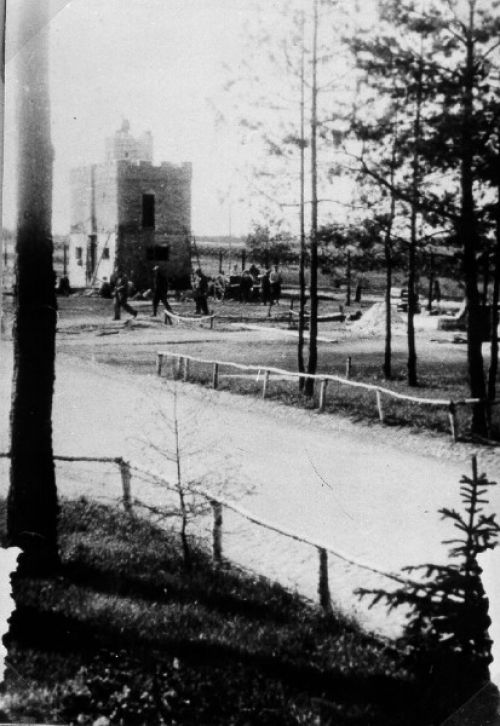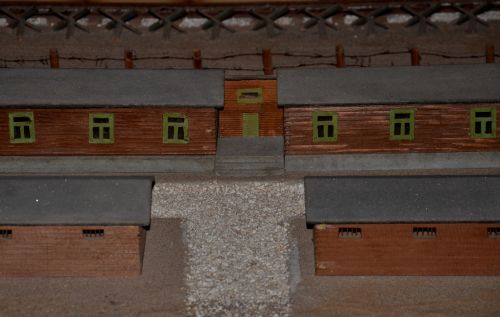The Armoury

Treblinka - The Armoury and the Kurt Seidl Strasse (Ghetto Fighters House)
The Armoury was erected between two SS barracks in the SS Living quarters at a later stage during the enhancements to the camp, during the spring of 1943.The building initially was a small 5 -meter wide, stone storeroom with a sloping cast concrete roof, with a high small barred window at the rear of the building and a large heavy metal door in the front.
This door, according to survivor Samuel Willenberg, was a special iron door with sixteenth -century style ornamentation and metalwork, requisitioned from outside the camp. The metalworkers in the camp installed the door in the doorway between the room and the corridor, and they were ordered to fit it with a stout lock.
The Armoury was of major importance during the planning and staging of the revolt which took place on August 2nd, 1943. This is where young boys working for the SS, used a clandestine key to gain access through the large metal door, that faced onto the Kurt Seidl Strasse, the camps main street, to obtain arms. These arms were passed through the small window, which overlooked the adjoining SS barracks, and were distributed and hidden by members of the camp's underground in readiness for the revolt.
Oskar Strawczynski in his memoirs 'Escaping Hell in Treblinka' recalled the Armoury, it is worth noting the point here, he disagrees with Samuel Willenberg that the heavy metal door was built in the camp's locksmith's workshop. As he worked there, maybe he has the final word on this issue:
'Between the two German barracks there was a small brick building which contained the German bathouse, as well as the armoury, which was shut with a heavy iron door. The door and lock had been constructed in our locksmith's workshop. At the same time a spare key was made which was later given to the committee. This allowed us to open and close the door of the armoury without attracting any outside attention. We had only to be on a sharp lookout for any approaching German. and especially for Kiewe, who was always riding around on his bicycle and turning up at every corner.
Samuel Willenberg wrote in his memoirs, 'Surviving Treblinka,' about the strange new structure:
'As the spring of 1943, approached, the Germans began developing and expanding the camp. They brought in a truck, driven by an SS man, and ordered construction materials - cement, iron and bricks. All of this was dumped in a heap between the pair of matching wooden huts where the Germans lived. These structures had been covered with straw to insulate them for the winter; now this was stripped off and we could assess the design of the buildings. Down the centre of each hut ran a corridor, with living quarters on either side...... The kitchen and mess hall - the latter furnished with little tables covered with snow-white tablecloths -were located in the front. There was a gap 5 meters wide between these huts, and here the Germans ordered us to erect a structure consisting of a corridor and a single room. A small detail of prisoners began to build . A few weeks later, when the walls were already standing, the Germans issued a strange command. Instead of having us clap a tar-covered wooden roof on the new building, like those of the other buildings in the camp, the Germans ordered one of poured concrete.

Yankiel Wiernik's model of Treblinka - SS Armoury (Photograph Ron Cohen -GFH)
A special iron door with sixteenth -century ornamentation and metal-work, obviously 'requisitioned' from outside, was brought in. Our metalworkers installed it in the new structure, between the room and the corridor, and fitted it with a stout lock. The Baumeister told the metalworkers to make two keys for the lock; they gave one to the Germans and hid the other. The Baumeister's conjecture was that the room would serve as an arsenal. If, so, then, when the time came to organise an insurrection, a copy of the key would be invaluable in giving us access to weapons. The Baumeister had guessed correctly, as everyone in the Baukommando knew within a few days. Our awareness of what possession of a key to the arsenal could mean spurred us to action and fanned our will to live and endure.
Tanhum Grinberg, another Treblinka survivor also recalled the Arsenal, and he spoke about another version of how the Jews obtained a spare key:
The Germans had a large arsenal inside the camp. We ceaselessly racked our brains to figure out a way of getting to it, but we did not get the slightest opportunity to do so. The arsenal was well guarded. Ukrainian guards surrounded it on all sides. But one day its locked got jammed. Our locksmith , a man whose wife and two daughters had perished in Treblinka, was ordered to repair the damaged lock. The door was taken down and brought to the workshop, and a special German guard was assigned to watch the locksmith while he did the job. Nevertheless, the locksmith was able to make a wax impression of the key. We were thus able to obtain our own key to the arsenal.
A few days passed before we were able to make use of it, take out 80 hand grenades and hide them in the cobblers workshop.
Samuel Willenberg described what happened at the armoury on the day of the prisoner revolt on August 2, 1943:
'It began shortly after three o'clock in the afternoon. Two prisoners, young boys who performed courier duties for the Germans, were given the key to the arsenal, which was held by the conspirators. They immediately took several buckets, and a stretcher which had been used for hauling garbage and rags, and slipped into the arsenal unnoticed. It was an ideal hour for this operation. The guards and SS men were tired from the heat of the day and paid no attention to what was going on around them. The boys were allowed to walk around near the Germans barracks, for their duties required this.
The entrance to the arsenal was not guarded, for several reasons. First of all, it was well sealed by iron doors and a barred window, which faced the rear of the building. Secondly, there were construction workers busy alongside the arsenal putting up a water boiler. Thirdly, the guards in the watchtowers were supposed to keep an eye only what was going on in the area, not what was happening inside the buildings.
The boys locked themselves in the arsenal and began to pass out rifles, ammunition, and hand grenades through the bars of the window to the construction workers, who were in on the conspiracy. Afterwards, they slipped outside, walked around the building and carried the arms to the centre of the camp on the stretcher, which was covered with rags. The grenades were taken in buckets covered with rags. Everything was placed beneath the piles of potatoes, which served as the location at which the weapons were distributed.
Wolf Sznajdman belonged to the privileged group of prisoners, the 'Court Jews' who were not watched as closely as the others. Consequently, at times they were even able to enter the armoury and take a weapon.
'There was an underground organisation which, for a few weeks before the revolt, gathered and began preparing everything. They made an additional key for the armoury in order to enter and remove weapons used by the Germans and Ukrainians. At first they were successful in removing grenades, but it proved to be for nothing, because they lacked detonators. They were returned to the armoury. This was even more dangerous. We removed them in the afternoon when there was quiet, and took them back in the evening when they (the SS) changed duties. Only one gun was left (with us) from that very first attempt. Later on, we succeeded in obtaining ammunition.'
Oskar Strawczynsk recalled:
'The Germans arranged their living quarters very comfortably and even had special guest rooms. A large bath-house was built with a tower for the waterworks. The black SS flag flew from the high tower
Sources
Peter Laponder, Re-Constructing Treblinka, Unpublished Work 2000
Oscar Strawczynski, Escaping Hell in Treblinka, Yad Vashem, Jerusalem 2007
Samuel Willenberg, Surviving Treblinka, Basil Blackwell, Oxford 1989
Chris Webb and Michal Chocolaty, The Treblinka Death Camp, Ibidem-Verlag, Stuttgart 2021
Photograph : Ghetto Fighters House Israel
Thanks to Madene Shachar and Ron Cohen - Ghetto Fighters House, Israel
Susan Straus
© Holocaust Historical Society September 23, 2022

